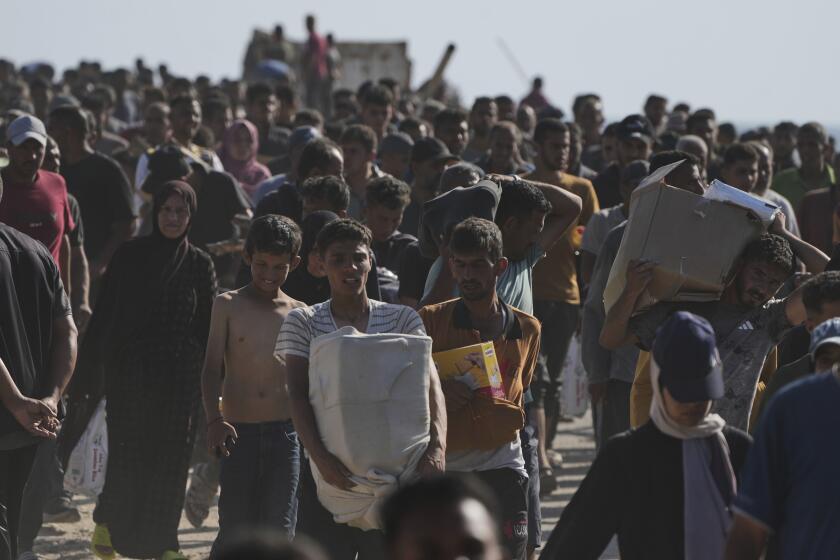THE NEW TRIBALISM: Defending Human Rights in an Age of Ethnic Conflict : Case Study: Bosnia-Herzegovina : A Tragic Portrait of Civilization Gone Wrong : ‘Ethnic cleansing,’ torture and killing feed a hopeless cycle of violence and revenge in the war-torn republic.
- Share via
SARAJEVO, Bosnia-Herzegovina — Hamed Celik’s punishment for being a Muslim was to become a human minesweeper.
First, Serbian nationalist gunmen held him for four months in a concentration camp in his home city of Foca, where he was systematically starved and haunted nightly by the screams of fellow prisoners being beaten to death. Then, the 57-year-old Celik was taken to the town of Kalenovik for front-line duty traversing mountain paths to ensure they were safe for Serbian troops.
“I saw one colleague from the Foca hospital blown up as he walked ahead of me,” the former ambulance driver recalled, his gaunt face flush with emotion. “I was lucky. I said to myself each time, ‘Only God can save me!’ And he did, because I was never wounded.”
Celik and four other Muslim prisoners were released in March in exchange for a Serbian gunman captured at the front line that encircles this shattered capital.
He now waits at his daughter’s home here for word from his wife, who fled the Foca terror for Denmark. Recovering in the relative comfort of this besieged and bedraggled capital, Celik is helping Sarajevo officials gather evidence for possible war crimes trials of the sadistic rebels who ran the prisons in Foca and Kalenovik.
If an international tribunal to hear Bosnian war crimes is ever established, as called for by the U.N. Security Council, it is expected to be flooded with demands for prosecution of extremists from all sides. The past 14 months have been tragically replete with cases like Celik’s.
Since a nationalist fever broke out in the Balkans with the rise to power of Serbian President Slobodan Milosevic, the peoples of the former Yugoslav federation have amassed a catalogue of human rights abuses. This war-torn republic stands as a portrait of civilization gone wrong--a worst-case scenario of man’s failure to respect his fellow man.
The war in Bosnia has brought to world attention both reminders of past inhumanity and violations of human dignity unique to this shockingly savage conflict.
The term “ethnic cleansing,” coined by Serbian nationalists in Belgrade to mean the forced displacement of non-Serbs, has been added to the euphemistic lexicon of zealotry, joining the Nazi allusion to the Holocaust as the “final solution” and communism’s cover for all manner of abuse with its labor camp sentences for “re-education.”
More than 2 million Bosnians--most of them Muslims civilians--have been uprooted from their homes by warfare and ethnic cleansing, forcing many into dreary and poorly supplied refugee camps where they wait, idle and hungry, for an end to the seemingly unstoppable war.
The technique of ethnic cleansing has been applied in a systematic manner throughout Serbian-occupied areas of the republic. The rebels broadcast demands for surrender of any weapons held by non-Serb civilians, who usually comply in areas where their numbers are too small to confront the heavily armed intruders. Men of fighting age, from 16 to 60, are then rounded up and taken off in trucks and buses for “questioning,” just before the surrounding artillery begins pounding the target area to drive women and children away. The attackers then move in for house-to-house searches to evict defiant stragglers.
Empty homes are then looted of the most valuable possessions and often burned to ensure that the displaced never return.
Destruction of cultural and religious monuments has been pervasive in all areas of Bosnia under Serbian and Croatian control.
Ancient mosques that stood in the heart of integrated cities like Bosanski Brod, Bijeljina, Zvornik and Banja Luka have been bulldozed into oblivion and the rubble carted away to get rid of the evidence.
Croatian extremists who have prevailed along the volatile Neretva River valley have done likewise to the Serbian Orthodox churches that once graced the eastern bank.
At Zitomislici, site of a 600-year-old monastery that was a sacred treasure of the Balkan Serbs, blasted stone and wood tumble toward the teal-blue waters of the Neretva from the hillside perch where monks only two years ago reburied eight of their World War II-era brothers who had been slaughtered by Croatian fascists and dumped in a nearby cavern. The walled monastery, the black-marble memorial, an icon-lined chapel and even the garlic garden on which the monks and nuns earned a meager living have been reduced to ruins.
By such acts of displacement and destruction, Bosnian Serbs have gained exclusive control of 70% of the republic, and the Croats, now matching the instigators’ aggression in kind, hold the rest except for six miserable enclaves where the Bosnian Muslims have been herded along with other opponents of segregation.
The tens of thousands of Muslim men detained by Serbian gunmen in Bosnia last spring and summer have mostly been released, under pressure from Western human rights organizations. But untold numbers remain missing from the rolls maintained by the International Committee of the Red Cross.
Survivors of some of the most heinous acts witnessed in Europe since the Nazi era, those held at infamous camps like those at Trnopolje, Keraterm, Omarska and Manjaca were exposed to abuse at the hands of criminal jailers who terrorized their prisoners with every weapon from psychological torture to summary executions.
A 37-year-old plumber released from Manjaca in November and deposited in the besieged town of Travnik estimated that as many as one-third of those he was held with at the Serbian-run camp died of injuries suffered in beatings, from hunger or disease and from drunken gunplay among the captors that often led to what has been termed “recreational killing.”
Celik, who has regained only a fraction of his former strength after detention saw his weight drop from 176 pounds to 114, recounted a harrowing year of mistreatment.
He was turned over to Serbs who had overrun Foca by the Montenegro Red Cross after registering as a refugee when he took his wife, elder daughter, son-in-law and two grandchildren to stay with friends in the town of Igalo, where they thought they would all be safe.
“We thought this would all end soon,” he said with a snort at his own naivete.
Celik was thrown into a cellar room with 20 other arrested Muslims, then transported by bus back to Foca to a former prison that had been converted to a concentration camp for 500 Muslims.
“At first I volunteered for work brigades, because those who worked got a second slice of bread,” said the former prisoner whose overriding memory of imprisonment is the pain and desperation of constant hunger. “When I was sent to work in the rose garden, I would pick grass and fill my pockets so I had something to eat late at night when no one was looking.”
The prisoners were allowed to bathe only once per month and were never, in the four months he was kept there, allowed to clean or change their clothes.
“It was worst between 6 and 7 p.m., because then the guards would come into the cell and pick two or three of us and take them away. We heard horrible screams and loud crashes and we never saw any of them again,” Celik recalled. “It was a kind of psychological torture--you never knew if it would be you.”
Much of the six months he was kept at Kalenovik swims together into a single bad memory of being summoned from his basement cell to lead the way along mountain trails the Serbs feared had been mined by the Muslims they had chased away.
Up to the day he was driven to the front-line town of Kula to be exchanged for the Serbian prisoner, he was told repeatedly he was to be killed and that all Muslims would be exterminated.
Asked what he was told about the reasons for his arrest and jailings, Celik quoted his captors as saying: “You are Muslim and this is war.”
The same explanation has been offered by the rebels who have used rape as a weapon.
Helsinki Watch, the international human rights monitoring organization, reported in a 422-page chronicle of abuses two months ago that all three sides in the Bosnian conflict--Serbs, Croats and Muslims--have used sexual violence against their enemies. A European Community investigation team as well as numerous other foreign rights foundations have determined that the vast majority of war rapes were committed by Serbs against Muslim women and estimate the violations in the tens of thousands.
Refugee camps flooded with expelled Bosnians are virtual dormitories of raped women. Hollow-eyed victims forced to maintain some semblance of a hold on reality in order to care for children and parents peer fearfully from the crowded and fetid floors of transient facilities, robbed of any chance at recovery as long as they are homeless and helpless.
Charges of sexual mutilation have also been raised against the Serbs, with Helsinki Watch having taken testimony from several victims who were either castrated or sexually disfigured during incarceration at the prisons and camps.
Although ICRC and other mediators have arranged dozens of prisoner swaps and releases that have eased the suffering of some victims of human rights abuses, those trying to restore some civility to Bosnia claim their failures far exceed their successes.
Jose Maria Mendiluce, special envoy for the area for the U.N. high commissioner for refugees, left his post here last month with blistering words for the rival warlords as well as for the politicians playing on the West’s sympathy for civilian victims.
“We must have access to all the suffering, but no one respects the need to help the other side,” he lamented. “They are all using us as a means of getting back at the others.”
U.N. refugee agency convoys are frequently subjected to delay or robbery by the ubiquitous gangs who have staked out stretches of Bosnia as their personal fiefdoms. The local commander of Bosnian Serb troops at the gateway city of Zvornik, for instance, has come to be known throughout the wreckage of Yugoslavia as the “King of the Bridge” for his power to permit or turn back humanitarian aid convoys.
Bartering with human lives has also become commonplace, especially in Sarajevo where the 400,000 holdouts are surrounded by Serbian siege lines and the sole point of entry and exit to the city is controlled by U.N. troops who have effectively promised to prevent crossings in return for the right to operate a relief airlift.
Whenever medical emergencies or family separations prompt Bosnians to appeal for a humanitarian exception to the rules so they can cross in or out of the city through the U.N. checkpoint, the peacekeepers are made mediators in what amount to life-or-death bargains.
“UNPROFOR is always asking the Chetniks for permission to let sick people get treatment, and the Chetniks then impose all kinds of conditions so that they can’t,” complained Darko Ivic, a Bosnian government liaison officer with the U.N. Protection Force that has 9,000 troops deployed in the ravaged republic.
Sarajevans tend to refer to the besieging forces as Chetniks, a World War II-era Serbian royalist army, to distinguish the rebel gunmen from the non-nationalist Serbs who have stayed by their side.
“Instead of humanitarian exceptions, we get demands for prisoner releases or for certain people to be removed,” Ivic said, noting that the negotiations often outlive the critically ill applicants.
The Sarajevo government has characterized the artillery siege of the country as organized terrorism and sought, unsuccessfully, to impress on Western powers that they have an obligation to intervene.
But the ethnic cleansing and other abuses have gone unabated and unpunished for 14 months, instilling a growing bitterness among the targeted civilians.
Dignity and security have been damaged, and treasured cultural and religious monuments are forever gone. But as the violent history of the Balkans has shown, the abuses are unlikely to be forgotten.
Today’s destruction will be seen by some to justify tomorrow’s bloodshed, and current atrocities will inspire more ferocious acts of retaliation, spurring Balkan history’s hopeless cycle of violence and revenge.
More to Read
Sign up for Essential California
The most important California stories and recommendations in your inbox every morning.
You may occasionally receive promotional content from the Los Angeles Times.














